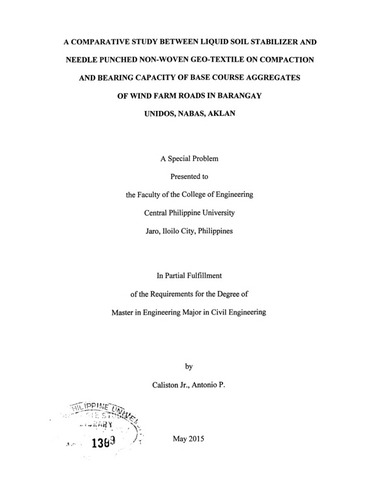A comparative study between liquid soil stabilizer and needle punched non-woven geo textile on compaction and bearing capacity of base course aggregates of wind farm roads in Barangay Unidos, Nabas, Aklan
| dc.contributor.adviser | Grio, Mary Earl Daryl | |
| dc.contributor.author | Caliston, Antonio P. Jr. | |
| dc.coverage.spatial | Nabas | en_US |
| dc.coverage.spatial | Aklan | en_US |
| dc.date.accessioned | 2021-03-09T06:54:07Z | |
| dc.date.available | 2021-03-09T06:54:07Z | |
| dc.date.issued | 2015 | |
| dc.identifier.citation | Caliston, A. P. , Jr. (2015). A comparative study between liquid soil stabilizer and needle punched non-woven geo textile on compaction and bearing capacity of base course aggregates of wind farm roads in Barangay Unidos, Nabas, Aklan (Unpublished Master's special paper). Central Philippine University, Jaro, Iloilo City. | en_US |
| dc.identifier.uri | https://hdl.handle.net/20.500.12852/579 | |
| dc.description | Abstract only | en_US |
| dc.description.abstract | Road conditions are affected by several factors such as pavement design, traffic loads and soil conditions supporting the road. At times, pavement design and traffic loads are the direct considerations but problems occur in cases when soils are not suitable for the road. Soil stabilization is important in this situation. For this research, soil stabilization was a solution for a macadam road used as an access for the delivery of wind turbines in Nabas, Aklan. The primary objective was to compare the effect of liquid stabilizer (RT-20) and needle punched non-woven geo-textile (PPN-200) on the degree of compaction and allowable bearing capacity of locally available base course aggregates in Nabas, Aklan. Field Density Test and Plate Load Test were conducted to the base course stabilized with geo-textile (PPN-200) and RT-20 respectively . Statistical analysis using Independent Samples T-test (SPSS22) on the results of the tests conducted using field density test showed that there was no significant difference between degree of compaction of aggregates treated with RT-20 liquid stabilizer and needle punched nonwoven geo-textile (PPN-200). Base course treated with RT-20 liquid stabilizer registered lesser settlement results compared to base course stabilized with needle punched non woven geo-textile (PPN-200). Even though, there is a significant difference in terms of settlement, aggregates base course treated with RT-20 liquid stabilizer and needle punched non-woven geotextile (PPN-200) showed that there was no significant difference on bearing capacity. However, based on actual derivations of unit cost; cost per kilometer of base course treated with RT-20 was less than the cost per kilometer of base course stabilized with needle punched non-woven geo-textile (PPN-200). Base-course aggregates treated with RT-20 was more economical than the geo-textile (PPN-200) (3,475,681.57 <4,117,474.11). | en_US |
| dc.format.extent | xi, 81 leaves: color illustrations | en_US |
| dc.language.iso | en | en_US |
| dc.subject.ddc | GSL Theses 620.072 C129 | en_US |
| dc.subject.lcsh | Soil stabilization | en_US |
| dc.subject.lcsh | Soil conditioners | en_US |
| dc.subject.lcsh | Soil stabilization--Equipment and supplies | en_US |
| dc.subject.lcsh | Roads | en_US |
| dc.subject.lcsh | Roads--Design and construction | en_US |
| dc.subject.lcsh | Farm roads | en_US |
| dc.subject.lcsh | Farm roads--Design and construction | en_US |
| dc.subject.lcsh | Philippines--Aklan | en_US |
| dc.subject.lcsh | Philippines--Aklan--Nabas | en_US |
| dc.title | A comparative study between liquid soil stabilizer and needle punched non-woven geo textile on compaction and bearing capacity of base course aggregates of wind farm roads in Barangay Unidos, Nabas, Aklan | en_US |
| dc.type | Special paper | en_US |
| dc.description.bibliographicalreferences | Includes bibliographical references | en_US |
| dc.contributor.chair | Molina, Dany C. | |
| dc.contributor.committeemember | Calibjo, Cirilo C. | |
| dc.contributor.committeemember | Rizardo, Erwin L. | |
| dc.contributor.committeemember | Gepulango, Gerardo G. | |
| dc.contributor.department | College of Engineering | en_US |
| dc.description.degree | Master of Engineering major in Civil Engineering | en_US |


